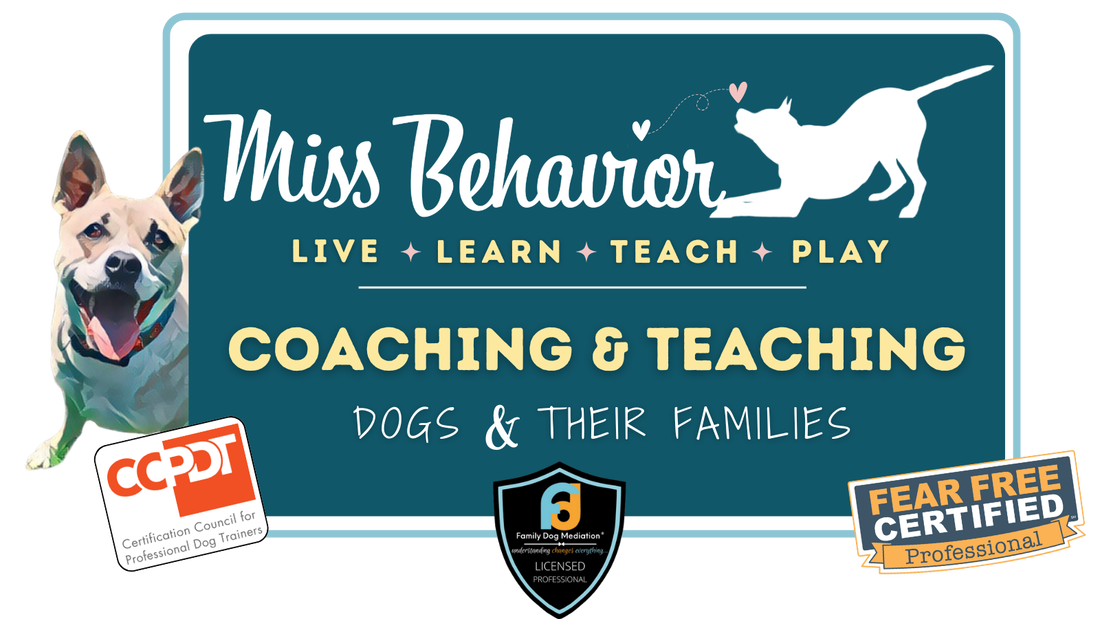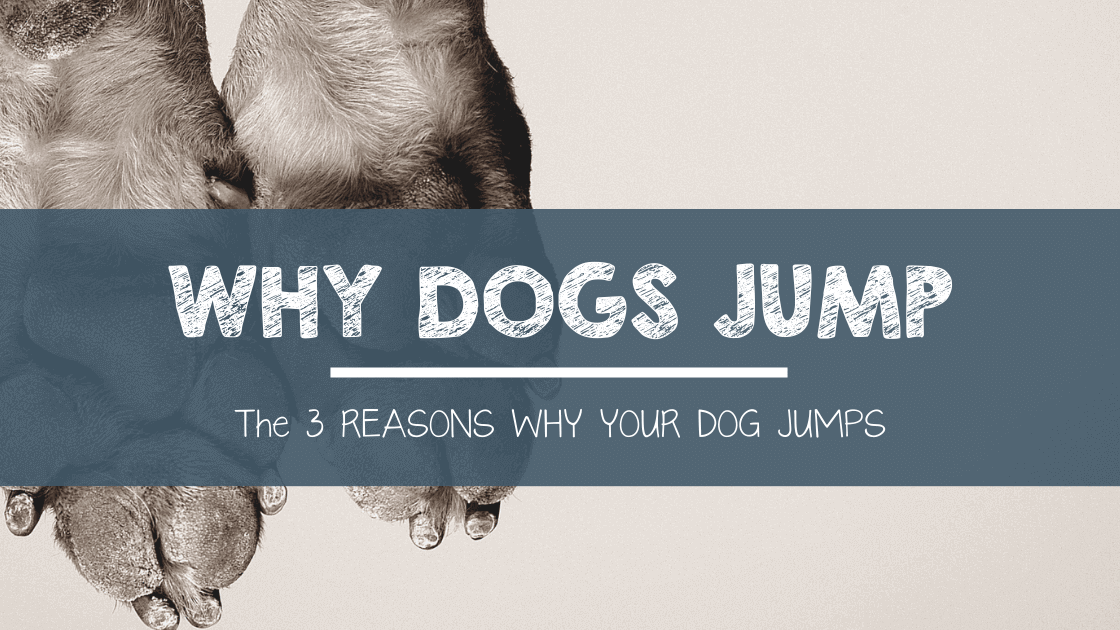|
11/4/2020 0 Comments The 3 Reasons Why Dogs JumpWhy does your dog jump? Before you can do anything about it, you need to know why it happensEvery behavior has a function with dogs. In the case of jumping, let’s look at what those functions might be so you can look at your own dog and breakdown which one(s) are most likely at play. Function #1: For attention Function #2: It feels good - It provides a Dopamine boost Function #3: To access to a resource In social animals, our attention plays an enormous role in our dog's behavior. They are often either trying to get closer to or further away from us. They are trying to increase or decrease distance. Attention seeking behaviors are distance-decreasing, by nature. There was a study done in 2012 (Dorey & al., 20128(11) that showed that dogs significantly decreased their jumping when access to what they wanted was not available for at least 20 seconds after jumping. Function #1: Attention SeekingWith attention-seeking dogs, they learn to jump when they realize that our eyes, face and hands (the things that give them the attention they want) are up above them. This starts at a young age when they tend to get reinforced for it more often because they’re little, and cute, and relatively harmless. Then they grow, and grow, and grow. Pretty soon, they’re still cute but a little less harmless when they jump! But while we changed the rules, we didn’t make that clear to them. We continue to reinforce the jumping, usually unconsciously. We might look at them, push them away, touch their collar, talk to them, pick them up, shush them, pet them, take action to give them something engaging. The point is, we engage with them in some way. We might even ask them to sit and then immediately engage with them. While technically, they were sitting when we reinforced them, it was the jump that trained us to say sit so that they could ultimately get attention. The jumping started that behavior chain, not the sitting. Sometimes, we try to discourage this behavior using methods such as squeezing the front feet, kneeing the dog in the chest, or stepping on the dog’s front feet. For some dogs, this doesn’t make a difference. It might even be engaging for the dog, interactive. However, for many dogs, it can cause a lot of conflict and anxiety. If some times, when you tried to interact and engage with someone familiar, they pinched you or stepped on your toes, it wouldn't take long for you to be in conflict too! For those dogs, you might even get a dog who pees during a greeting and circles around us, anxiously but excitedly. Yet the behavior continues. This often happens because of conflict. The dog is excited but also avoidant. Function #2: It feels goodLook, some dogs just like to jump. It's their own unconscious behavior that their body automatically defaults to at times of high arousal and excitement. This reminds me of my 6 year old son. When we play board games and he's winning, he gets really excited. So excited, in fact, that he can't sit still. He bounces from one couch to another in anticipation. Until, on the next move, he gets sent back home (i.e. Trouble or Sorry) or he begins suddenly losing. Then he's emotional on the other end of the spectrum. Either way, his emotions get in the way of his impulses. Function #3: To gain access to a resourceEver leave a paper towel on the counter, only to suddenly have it appear in your dog's mouth when you turn around? How about a sandwich? Whether you have a counter-surfing or a table-surfing, basket-surfing kind of a dog, many dogs jump to access resources that are above their head. They jump because they can't reach something on all fours but they are physically able to reach it when they put those paws up on something. Makes sense... we might not like it but from a functional perspective, it makes perfect sense! So what is your dog's function for jumping? Likely, there is more than oneBut again, before you can change a behavior, it's helpful to understand the function. For example, if your dog is trying to gain access to something specific on the counter and jumps for that reason and you push him down, you might not be mistakenly reinforcing him. But if he's just curious about what's up there and checking it out for a good time, you likely are reinforcing him by pushing him down. You're engaging with him, feeding into his curiosity for seeking out some kind of attention. If your dog gets a Dopamine rush from jumping and really enjoys it but you are trying to get him to sit still when excited, you are running an uphill battle. You are forcing him to go against all bodily instincts. You are telling him to sit still when he's excited but not giving him an alternative So now what? What can you do about the jumping? As Maya Angelou has said, "When you know better, do better" Now that you've thought about why your dog jumps, it's time to think about how you could better reinforce your dog for the right behaviors. To get your wheels turning, think about this Function #1: Attention-Seeking What alternative behavior could you teach your dog that will replace the jumping? Sit, Lie Down, Go to Bed, Play Dead, Chin Rest, Nose-To-Hand Targeting... to name just a few. But keep in mind, chaining behaviors together is a very real go-to for dogs as well. If you dog has to jump in order for you to ask him to sit so you can then reward him, it was the jumping that trained you to ask for the sit so he could get reinforced. The sit needs to come first. Function #2: It feels good You could actually put the jumping on cue and use it as a reinforcer for good behavior. Sit-Stay while I put your leash on, then good boy, "jump jump" (in the air, not on you) and you move on. Seriously. I'm telling you to put the jumping on cue so you can use it as a reinforcement. It takes practice and very clear and consistent boundaries but for a dog who loves to jump, it can be a really great cued-behavior Function #3: To access a resource First, make sure those resources are in inaccessible when your dog is on his own. Stop that cycle right there. If your kitchen counter is full but you need to go into the bathroom, invite your dog to come with you. Use an exercise pen to block off the kitchen while you go upstairs. When you are present, reinforce your dog for keeping four-paws-on-the-floor despite seeing a temptation up high. Play the "Find It" Game while you cook. Or Down-Stay... or that exercise pen again. Don't allow rehearsal of the behavior. Management is important here but so is noticing the good choices! Need more help breaking this down, piece by piece?If you break a big, complicated behavior down into smaller steps before putting all those pieces back together, your long term success will be much better, much stronger.
My 14-day PAWS OFF Challenge does just that. Check it out today!
0 Comments
Your comment will be posted after it is approved.
Leave a Reply. |
|
- Home
- About
- Blog
- Services
- Membership
-
Courses & Freebies
- All Courses
- FREE Boredom Buster Recipes
- COURSE: Building Resilience in your Family Dog
- COURSE: Managing the Leash Walk
- Potty Training COURSE
- Paws Off COURSE
- COURSE: Managing the Leash Walk
- FREE Attention Building Challenge
- FREE Scratchboard Training
- FREE Rest and Recovery Round-Up
- FREE Body Language 101
- Contact
- Home
- About
- Blog
- Services
- Membership
-
Courses & Freebies
- All Courses
- FREE Boredom Buster Recipes
- COURSE: Building Resilience in your Family Dog
- COURSE: Managing the Leash Walk
- Potty Training COURSE
- Paws Off COURSE
- COURSE: Managing the Leash Walk
- FREE Attention Building Challenge
- FREE Scratchboard Training
- FREE Rest and Recovery Round-Up
- FREE Body Language 101
- Contact
Search by typing & pressing enter





 RSS Feed
RSS Feed





